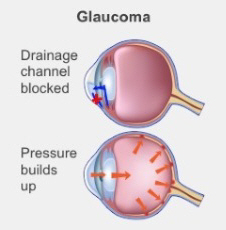Papahewa Glaucoma
About glaucoma
The eye has a pump that produces a small amount of fluid to keep enough pressure in the eyeball, so it does not collapse. If this fluid drains properly, the eye pressure (also called intraocular pressure) is low, but if it does not drain easily, the eye pressure rises. If the pressure gets too high, the optic nerve can be permanently damaged.

It is also possible for your optic nerve to be damaged even if your eye pressure is normal.
Glaucoma is often detected during routine eye examinations. If it is caught early, it can be treated so you do not lose your sight.
Glaucoma is more common as you get older, with about one in 10 people over 70 years old having it.
You are also at a higher risk of glaucoma if you:
- have parents, brothers or sisters who have glaucoma
- have raised eye pressure
- have used steroid (corticosteroid) eye drops, tablets or inhalers for inflammatory conditions
- have injured your eye in the past
- are long or short-sighted
- have eye damage from diabetes or high blood pressure.
Types of glaucoma
There are many different types of glaucoma, which can cause different symptoms and need different treatments.
Most people have open-angle glaucoma. In this type of glaucoma, fluid cannot flow out of your eye properly, and the pressure gets too high. The American Academy of Ophthalmology has produced a video that shows how it happens.
What is glaucoma? — YouTube (external link)
Some people get acute angle-closure glaucoma, but this is less common. In this type of glaucoma, the channels draining fluid from your eye become completely and suddenly blocked.
Other types of glaucoma include:
- low-tension glaucoma
- angle-recession glaucoma
- steroid-induced glaucoma
- pigmentary glaucoma
- neovascular glaucoma.
Occasionally, babies are born with glaucoma.
Symptoms of glaucoma
Most people with open-angle glaucoma have no symptoms until the disease is severe.
The first signs you may notice are usually blind spots at the sides of your vision (peripheral vision loss) and in some cases reduced central vision.
In cases of acute angle-closure glaucoma and some other causes of glaucoma, you may suddenly develop the following symptoms:
- blurred vision
- seeing coloured halos around lights
- eye redness
- nausea or vomiting
- pain in your eye.
Diagnosing glaucoma
Glaucoma is diagnosed by testing your vision, including peripheral vision (visual field tests), looking through your pupil directly at the optic nerve and by measuring your eye's pressure (intraocular pressure).
A good first step is to see an optometrist for these tests. You can also see your healthcare provider, but they may advise you to see an optometrist who can do more detailed tests.
If your optometrist or healthcare provider think you may have glaucoma, they will refer you to an ophthalmologist (eye doctor) who can confirm the diagnosis and start treatment.
Treating glaucoma
There is no cure for glaucoma, but there are treatments that can control it and prevent further damage. Unfortunately, any existing damage to the optic nerve is permanent. If you do not treat glaucoma, the damage will get worse, and you can lose your sight.
Treatment for glaucoma aims to lower the pressure inside your eye to prevent any further damage to your optic nerve. It can do this in 2 ways:
- helping the fluid drain from the eye
- reducing the amount of fluid made in the eye.
You will need to continue treating your glaucoma for the rest of your life.
The main treatment is with medicated eye drops and sometimes tablets. You might also have laser treatment, surgery or a combination of these methods.
Glaucoma medications come in different strengths and combinations. Eye doctors (ophthalmologists) try to use the smallest amount of medication with the fewest side effects. You might need several medications that complement each other. You will need to use medications every day to control the pressure in your eye.
Like all medicines, the eye drops can have side effects, although many people do not get them. Mild eye irritation or pain is common. But if your eyes are always sore, your vision is blurred or you develop a red rash around your eyes, you should speak to your healthcare provider as soon as possible.
Reducing your risk of glaucoma
The best way to prevent glaucoma damaging your sight is to have regular eye examinations. How often you should have an eye examination depends on your circumstances:
- If you have a parent, brother or sister with glaucoma, have an eye examination every 2 years after you turn 40.
- If you are aged 40 to 60, have one at least every 5 years.
- If you are over 60, have one at least every 3 years.
- If you have had a significant eye injury, have an eye examination every year for the rest of your life.
- If you use steroids regularly, make sure you have an eye check once a year.
Related websites
New Zealand Association of Optometrists external link
Information about the symptoms and treatment of glaucoma as well as who is at risk of glaucoma.
Glaucoma New Zealand external link
Information about glaucoma and support for people who have glaucoma.
Clinical review
This content was written by HealthInfo clinical advisers. It has been adapted for Health Information and Services.